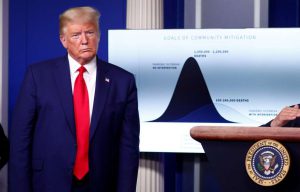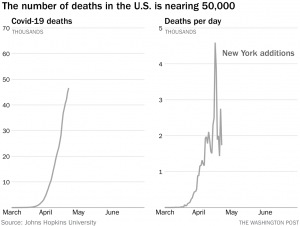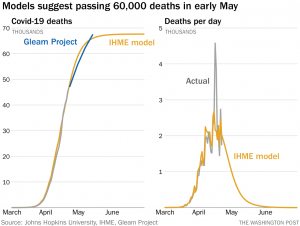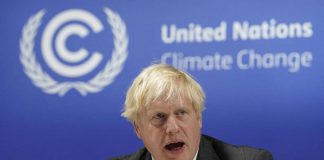APRIL 23, 2020

President Trump stands in front of a chart during a coronavirus response briefing at the White House, March 31, 2020. (REUTERS/Tom Brenner)
When the White House announced its recommendation last month that Americans refrain from meeting in groups and take other steps to contain the spread of the coronavirus, it presented a chart suggesting that doing so could avoid the worst-case scenario of infections. Without mitigation efforts, models of the spread of the disease estimated that as many as 2.2 million Americans could die of covid-19, the disease caused by the virus. With mitigation? A more modest 100,000 to 220,000 deaths. Still a lot, but obviously far better.
It was a hard message for President Trump, for a variety of reasons. No president wants to tell the public that the best-case scenario from a crisis is that hundreds of thousands of people would die. But that’s what the data showed, and so that’s what was presented in defense of urging people to stay home.
As time passed, the models were revised with new information. One leading model used by the White House, created by the Institute for Health Metrics and Evaluation at the University of Washington, used new information about distancing measures in Europe and the United States to shift its downward estimate for the death toll from 90,000 to a little over 60,000.
Trump relished the change.
With 60,000 deaths, “you can never be happy,” Trump said at a briefing on April 10, shortly after the model revision. “But that’s a lot fewer than we were originally told and thinking. So they said between [100,000] and 220,000 lives on the minimum side, and then up to 2.2 million lives if we didn’t do anything. But it showed a just tremendous resolve by the people of this country. So we’ll see what it ends up being, but it looks like we’re headed to a number substantially below the 100,000. That would be the low mark. And I hope that bears out.”
“We did the right thing,” he said a bit later, “because maybe it would have been 2 million people died instead of whatever that final number will be, which could be 60, could be 70, could be 75, could be 55. Thousands of people have died.”
A week later, the same argument.
“I think we’ll be substantially, hopefully, below the [100,000] number,” he said. “And I think, right now, we’re heading at probably around 60-, maybe 65,000.”
As recently as Monday, Trump again touted this number.
“We did the right thing, because if we didn’t do it, you would have had a million people, a million and a half people, maybe 2 million people dead,” he said. “Now, we’re going toward 50, I’m hearing, or 60,000 people. One is too many. I always say it: One is too many. But we’re going toward 50- or 60,000 people.”
We are not. We’ll pass 50,000 within days and will likely hit 60,000 deaths by early May. That’s just recorded deaths. The actual death toll will almost certainly be much higher, as deaths outside hospitals and ones that were not preceded by coronavirus tests — including some in early February in California — are added to the total.
Trump’s embrace of the 60,000 number appears to be a combination of misunderstanding the IHME revision, misunderstanding what the White House was asserting in the first place and a function of the necessary vagueness of determining death tolls in the first place.
As of this writing, Johns Hopkins University estimates that about 47,000 people have died of covid-19, the disease caused by the coronavirus. For several weeks, the number of new deaths a day in the United States has hovered around the 2,000 mark. New York City’s decision to add suspected covid-19 deaths to its tally pushed up the national total for several days last week.

Obviously, even assuming that later estimates track precisely with the recorded total, the idea that only 3,000 more people will die from coronavirus is ridiculous. The idea that only 13,000 will seems unlikely, barring a sudden and dramatic decrease in new deaths — a decrease that holds indefinitely.
Models of the possible death toll, including IHME’s, have the country passing 60,000 deaths in the first week in May. A model created by a number of university and nongovernmental groups called the Gleam Project suggests that by May 7, there will be more than 62,000 deaths. On that day, IHME’s number is closer to 64,000.

The IHME model does show the number of deaths tapering off in May, which is good news. But that introduces another aspect of its model that Trump seems to have misunderstood or overlooked: It is modeling only the first wave of infections.
The IHME model has two limitations that should be considered when looking at what it projects. The first is that the model assumes a pattern of deaths that depends on the sort of tapering-off shown in the second graph above. The second is that its estimates only ever went to early August.
In other words, even when people were celebrating its downward revision to 60,000 deaths, that was still only the estimated total through the early summer. It didn’t include any estimate of what might happen should there be a resurgence in the presence of the virus this fall and winter, as we usually see with the flu. (IHME’s projected death toll through July is now about 67,000.)
Centers for Disease Control and Prevention Director Robert Redfield kicked up a storm this week when he predicted that this winter could be a bigger struggle than what we’re seeing now, thanks to the combination of coronavirus (for which we’ll still likely lack a vaccine) and the seasonal flu. Trump, eager to assuage concerns about the virus, brought Redfield to Wednesday’s briefing to explain his comments.
“You may not even have corona coming back, just so you understand,” Trump said after Redfield confirmed his comments.
“Wouldn’t you say there’s a good chance that covid will not come back?” Trump asked White House coronavirus task force member Deborah Birx.
“We don’t know —” Birx replied with some hesitation.
“And if it does comes back, it’s in a very small, confined area that we put out,” Trump interjected.
That’s not necessarily true. The United States will certainly be better prepared for a reemergence of the virus this fall, but the same core problems may remain: limited immunity, limited therapeutic medications, no inoculations. And that means that the death toll will likely continue to climb. As it may for months after, until there’s either sufficient immunity in the population, an effective treatment, or a vaccine.
Trump at times has compared the death toll from covid-19 to the toll from the H1N1 flu pandemic in 2009. The CDC estimates that more than 12,000 people died of that virus from April 2009 to April 2010. (The comparatively low death toll is likely why Trump doesn’t compare it with covid-19 anymore.) That’s an estimate, based on observed illness totals and documented deaths. It’s similar to the annual estimates the government compiles to determine how many people died from the seasonal flu, part of its determination of the “disease burden” that influenza exacts each winter. In the 2018-2019 flu season, for example, the CDC estimates that roughly 34,000 people died of the flu, a figure that could be as low as 26,000 or as high as nearly 53,000.
It’s a scientific estimate that is higher than the observed death toll. (Only about 7,000 flu deaths were directly recorded that flu season.) Eventually, we’ll get a similar estimate of how many deaths covid-19 has caused. It, too, is likely to be higher than the numbers we have now.
In that chart that the White House presented back in March, the timeline on which the number of deaths would be recorded was not identified. If the lower estimate, those 100,000 to 220,000 deaths, were only measured through July of this year, then we’re on target to come in well under the lower boundary. But if it was over the entire spread of the virus’s emergence, tracking from March 2020 through the summer of 2021, we can be less certain about whether 100,000 was an overestimate. Particularly once the final estimate of the virus’s toll is calculated.
For Trump, the question was simple. The lower estimate said 100,000, and here was a model suddenly throwing out a figure of 60,000. Trump, in Trump fashion, embraced it, even slicing off a few thousand now and again.
Reality refuses to be so generous.
Courtesy/Source: Washington Post

































































































